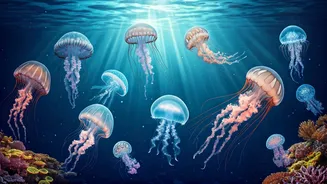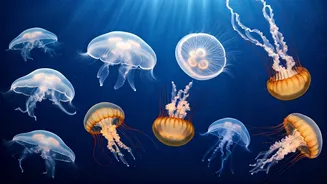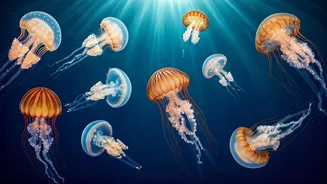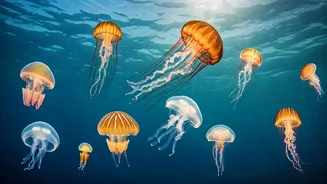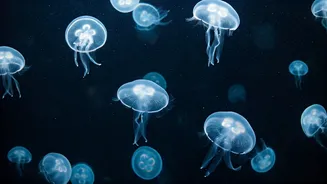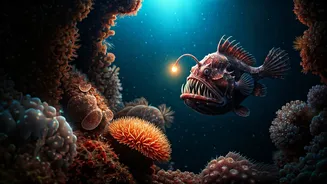Crystal Jelly
The *Aequorea victoria*, commonly known as the crystal jellyfish, is renowned for its bioluminescence. Native to the Pacific Northwest, these jellyfish emit
a vibrant green glow when disturbed, a defense mechanism to ward off predators or a way to attract prey. They are relatively small, typically measuring only a few centimeters in diameter, and their transparent bodies allow for a clear view of their internal structures. This transparency makes them a favorite subject for scientific research. Crystal jellyfish have been instrumental in biological studies, especially the discovery of green fluorescent protein (GFP), which has revolutionized cell biology and earned a Nobel Prize. The GFP allows scientists to visualize biological processes within cells, making it a pivotal tool in modern research.
Moon Jelly
The moon jellyfish (*Aurelia aurita*) is one of the most widely recognized jellyfish species due to its translucent, moon-like shape. They are found in oceans worldwide and are easily identified by their four horseshoe-shaped gonads, visible through their bell. Moon jellyfish are relatively simple organisms, primarily consisting of water. Their diet consists mainly of plankton, which they capture with stinging cells called nematocysts located on their tentacles. They reproduce both sexually and asexually, allowing them to rapidly colonize favorable habitats. Moon jellyfish play a crucial role in marine ecosystems, providing food for larger animals like sea turtles and acting as a predator of small fish and larvae. Their abundance and adaptability make them a key player in the balance of marine food webs.
Box Jelly
Box jellyfish, particularly those in the *Chironex fleckeri* species, are infamous for their potent venom. Found in the Indo-Pacific region, they are distinguished by their cube-shaped bell and numerous tentacles, each covered with thousands of nematocysts. Their venom is exceptionally toxic, causing intense pain, cardiac arrest, and sometimes death in humans. Box jellyfish are active hunters with relatively advanced vision, possessing complex eyes that allow them to navigate and hunt prey effectively. They are primarily carnivores, feeding on fish and crustaceans. These jellyfish have a complex life cycle, including both polyp and medusa stages, and are highly adapted to their coastal habitats. The study of box jellyfish venom continues to be an area of interest in medical research, with efforts focused on developing effective antivenom and treatment protocols.
Lion's Mane
The lion's mane jellyfish (*Cyanea capillata*) is the largest known species of jellyfish, with some individuals reaching bell diameters exceeding 100 feet. They are easily recognized by their massive size and dense, flowing tentacles, which resemble a lion's mane. These jellyfish are commonly found in cold, northern waters of the Pacific and Atlantic Oceans. Their tentacles, which can extend up to 120 feet, are covered with stinging cells used to capture prey, mainly small fish, plankton, and other jellyfish. The color of lion's mane jellyfish varies depending on their diet and location. They play an essential role in their ecosystems, providing food for larger marine animals. Their imposing size makes them a formidable presence in the ocean, and they are a source of fascination for both scientists and divers.
Irukandji Jellyfish
Irukandji jellyfish, small but incredibly dangerous, belong to several species within the *Carukia* genus. Native to Australian waters, these tiny jellyfish (typically only a few centimeters in diameter) can inflict a severe and often life-threatening condition known as Irukandji syndrome. Symptoms include excruciating pain, muscle cramps, vomiting, and a dangerous rise in blood pressure, potentially leading to heart failure. Despite their small size, their venom is extremely potent. Irukandji jellyfish are challenging to detect due to their transparency and small size. Research efforts focus on understanding their venom and developing effective treatments. The study of these jellyfish underlines the importance of marine safety and the impact of even the smallest creatures in complex ecosystems.
Flower Hat Jellyfish
The flower hat jellyfish (*Olindias formosa*) is a strikingly beautiful species known for its vibrant colors and intricate patterns, resembling a blooming flower. Found in the Pacific and Indian Oceans, these jellyfish feature a bell with numerous tentacles and oral arms, often adorned with bright colors like pink, red, and yellow. They are relatively small compared to other jellyfish species, typically measuring between 10 to 20 centimeters in diameter. Their tentacles are equipped with stinging cells used to capture small fish and other prey. They exhibit a fascinating life cycle and are considered less harmful to humans than some other venomous jellyfish. The beauty and complexity of the flower hat jellyfish make them a favorite subject for underwater photography and marine biology studies.
Comb Jelly
Comb jellies, or ctenophores, are not true jellyfish but gelatinous marine animals closely related to them. They differ from jellyfish because they lack stinging cells, relying instead on sticky cells called colloblasts to capture prey. Comb jellies are characterized by their eight rows of ciliated combs, which refract light and produce a shimmering, iridescent effect when they move through the water. They are found in oceans worldwide and play a significant role in marine food webs, consuming plankton and small invertebrates. Comb jellies come in various shapes and sizes, ranging from small, spherical forms to long, ribbon-like creatures. Their transparent bodies often make them difficult to spot, but their bioluminescence and unique movement patterns make them a fascinating subject for marine research and observation.
Upside-down Jellyfish
Upside-down jellyfish (*Cassiopea*) live upside down on the seafloor, unlike most jellyfish. They reside in shallow, tropical waters and exhibit a unique symbiotic relationship with photosynthetic algae. They lie on their bell with their tentacles pointing upwards, exposing their symbiotic algae to sunlight to generate energy through photosynthesis. This allows the jellyfish to obtain a portion of their food from the algae. They are relatively large and colorful, often found in large aggregations, creating underwater meadows. They primarily feed on plankton, which they capture using their stinging cells. Their behavior and symbiosis offer interesting insights into how different organisms interact in marine environments. Upside-down jellyfish contribute to the biodiversity of their habitats, often providing shelter for small fish and invertebrates.
Sea Nettle
Sea nettles, particularly *Chrysaora quinquecirrha*, are common jellyfish found along the coasts of North and South America. They are recognized by their translucent, bell-shaped bodies and long, flowing tentacles. Sea nettles have a mild sting, causing a stinging sensation upon contact. These jellyfish feed on plankton, small fish, and other jellyfish, using their tentacles to capture prey. Sea nettles can reproduce both sexually and asexually and play a significant role in coastal ecosystems. Their population can fluctuate, and they can sometimes form large blooms, which can impact recreational activities and fisheries. The study of sea nettles and their impact on marine environments is a continual area of scientific investigation.
Purple Striped Jellyfish
The purple-striped jellyfish (*Chrysaora colorata*) is a visually striking species known for its vibrant purple stripes and bell. Found along the West Coast of the United States, they often form large blooms, turning the waters a distinctive color. These jellyfish have a moderately painful sting, though rarely life-threatening to humans. They are carnivorous, primarily feeding on other jellyfish, zooplankton, and small fish. They also have a significant impact on marine ecosystems, and their life cycle includes both a free-swimming medusa stage and a polyp stage attached to the seafloor. Their blooms are closely monitored, as they can have ecological and economic consequences, including impacts on tourism and fisheries. They contribute significantly to the beauty and biodiversity of their coastal habitats.
